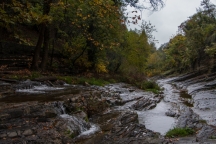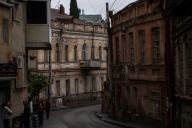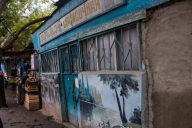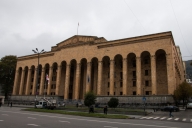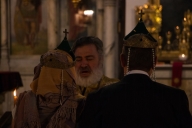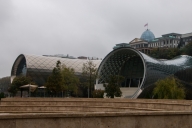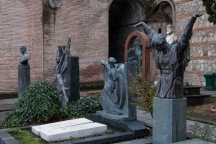Last visited in October 2016.
When we landed at Tbilisi International Airport on my first visit in 2013, it was full of promotional posters reading “Tbilisi. The City that Loves You”. By the time we were getting on our return flight, I could honestly say that the feeling was mutual.
On our first trip, we stayed in a small hotel on Leselidze (now Alkhazi) street, right in the heart of the old center of town, and a perfect location for exploring. One good way to get your bearings is to start your Tbilisi tour by going up to Narikala fortress for a bird’s-eye view of the city. You can’t miss Narikala as it dominates the old town skyline. There are two ways of getting up to the fortress – you can walk up from Meidaini Square or take the cable car from Rikhe park across the Mktvari (Kura) river. We took the easy way up.
As you look over Tbilisi from Narikala’s walls, you can’t help but notice the shiny modern buildings gleaming against a backdrop of the older sometimes decrepit-looking Ottoman-era houses of the old city. This has been as controversial with the Georgians as has the Saakashvili government that initiated this modernization, but I find that the mixture of old and modern architecture only adds to the city’s considerable charm. Unfortunately, it appears that some of the modern buildings started under Saakashvili will never be finished for political reasons and it remains to be seen what will take their place. There is not much to see in the fortress itself, but next to it is the Soviet-era Mother Georgia monument – a 20 meter high aluminum sculpture, in the manner of similar (and in my opinion mostly ugly) creations in other former USSR capitals, notably Kiev and Yerevan.
After you take in the view, it’s a good idea to go down into the Botanical garden, located in a picturesque river valley right behind the castle. Founded in 1845, this is the first Botanical Garden in the Caucasus and a tranquil place with a lovely waterfall, plenty of trees and a nice walk back into old Tbilisi after an hour here.
Take some time exploring Old Tbilisi, just follow Leselidze and some of the smaller traffic-free streets along the riverbanks. As you head North, check out Sioni Church with its distinctive architecture and beautiful setting. At the North end of Shavteli street you will find a quirky watchtower building, signifying the famous Rezo Gabriadze Marionette Theater. Even if you don’t have the time to attend a performance in the theater, you might want to check out the café next door, decorated with designs and drawings by Gabriadze himself.
Be prepared that Tbilisi is not a glamorous city and it has survived a long period of neglect, civil strife and economic hardship, all of which shows. But the city still has a lot of charm and even some of it’s more unkempt streets and buildings are incredibly atmospheric.
Legend has it that King Vakhtang Gorgasali founded Tbilisi in the 5th century after witnessing a wounded deer he hunted fall into a sulphur hot spring and be miraculously healed. Sulphur baths were built on these hot springs and an entire part of Old Tbilisi called Abanotubani is dedicated to them. These are functional to this day and you can smell the brimstone in the air as you walk around this area. Most of the bath houses here are subterranean with ground-level domes. The exception is the Central Asian-style Orbeliani baths, which was closed for renovations, during both our visits. Visiting a sulphur bath is a must for your complete Tbilisi experience. You can spring for a private room, or just try the public baths. Here is a good article on what you can expect in the public baths.
Another part of Tbilisi worth exploring is Rustaveli Avenue, the main street of modern Tbilisi. The avenue starts at Freedom Square and goes for about 1.5 kilometers. Sights along here include the former Parliament building (no longer used as the new Parliament moved to Kutaisi, three hours away), the Georgian Opera and Ballet Theater (recently reopened after a lengthy restoration), Kashveti Church and the Georgian National Museum, home to the National Gallery. The gallery is a must see for anyone interested in Georgian culture, as it houses bbthe paintings of Niko Pirosmani, the country’s famous primitivist artist.
After you finish exploring with Old Tbilisi and Rustaveli Avenue, take a walk across the Peace Bridge to the other side of the Kura river. This part of town is dominated by the Tsaminda Sameba (Holy Trinity) Cathedral, completed in 2004 after a decade of construction. On the way up to the Cathedral, check out Rhike Park, if you haven’t done that already on way up Narikala Fortress. The controversial twin buildings of Musical Theater and Exhibition Hall stand here unfinished still and may never be completed, as mentioned above. Just uphill from the park is the Presidential Palace with its distinctive egg-shaped glass dome. The palace is not open to the public, but still worth a look on the outside as you go up to the Tsaminda Sameba Cathedral.
Other than these main attractions, there are some beautiful older buildings and squares on the left bank of the Kura and it’s worth strolling around, if you have the time.
In our two short stays in Tbilisi, we did not visit many museums, but one place I plan to visit, when I come back here is the Open Air Museum of Ethnography.
Food, is a big deal in Georgia and in our time here we did not have one mediocre meal. But there were three places that stood out – two fancy ones, the third not so much. One was called Tsiskvili (“mill” in Georgian) and it had great, if a bit pricey ethnic food, a terrific atmosphere, but most importantly – great traditional music, singing and dance shows. They have a good website, if you want to learn more about them. This one will be a cab ride from downtown.
The second restaurant is called Funicular and is located high above the city on Mt. Mtatsminda, right on the second stop of the funicular up the mountain. Great food, great outdoor seating, great views of the city. The restaurant is next door to Mtatsminda park, where you can spend some time walking off your meal and maybe take in the great city view from the ferris wheel. On the way down, it’s a good idea to get off at the first funicular stop and check out the Pantheon of Public Figures – a lovely mountainside church with a small cemetery, the final resting place of Georgia’s first president Zviad Gamsakhurdia and Russian writer Aleksandr Griboyedov.
My third and final food recommendation is actually a budget chain of khachapuri (a type of cheese bread) restaurants called Machakhela. With its flagship restaurant right in the main old town square, this place serves great unpretentious local staples including a huge variety of its signature dish khachapuri, khinkali and good house wine, for 24 hours every day
The beauty of Tbilisi, though is that there are streets and streets of great bars and restaurants, a lot of them in the old city. We whiled away quite a few very enjoyable hours on the outdoor terraces of these places.
If you are looking to do some souvenir shopping, check out the Dry Bridge flea market – which has a great selection modern art, old Soviet kitsch and other curios.
If you are looking to take back some nice Georgian wine (and chances are you will be), your best bet is Vinotheca in old town. This store has very enthusiastic and knowledgeable staff. And don’t forget go out drinking, meet some locals, stay out late and enjoy the bnightlife. You will have a blast. After all – this city loves you!



